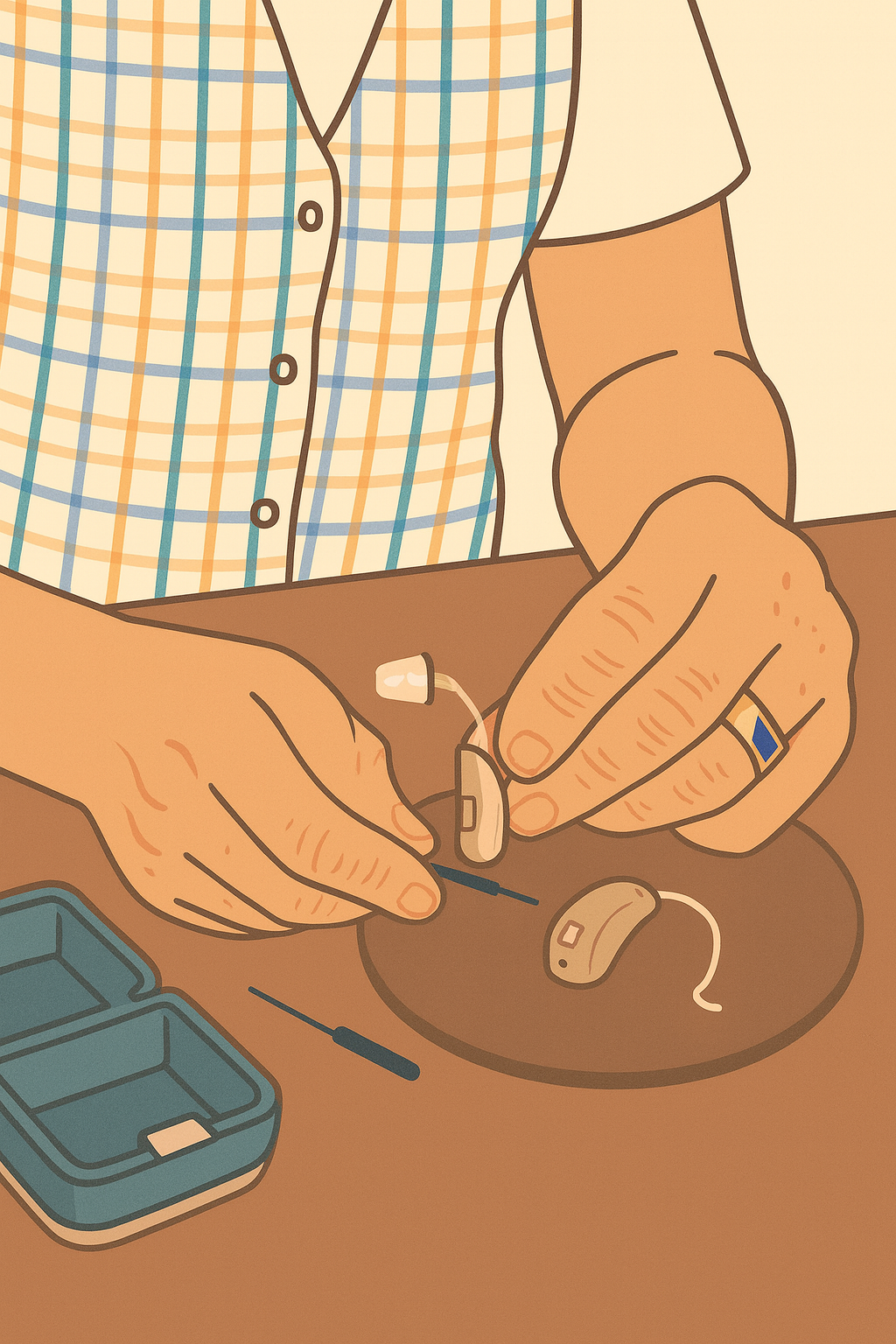
Ultimate Guide to Cleaning and Caring for Hearing Aids: Tips for Longevity and Performance
The lifespan and performance of your hearing aids can be affected by how well and regularly you clean them. Earwax and skin particles can adhere to them, causing occlusions and reducing your hearing aid's capabilities of capturing and transmitting sound. Regular cleaning prolongs the hearing aid's lifespan and prevents hearing aid damage.
How do you care properly for your hearing aids? This guide will give you hearing aid care tips and provide you with a hearing aid maintenance guide.
Understanding the Components of Hearing Aids

Source: Hearing Industries Association
A hearing aid is a delicate electronic mechanism consisting of different amplifying parts. Every type of hearing aid is different, but all share the same fundamental components:
- The microphone: The microphone collects the sound from the environment and sends it to the amplifier. The advanced technology in modern digital hearing aids allows them to differentiate between different sound types, such as speech, music, or background noise.
- The amplifier: The amplifier receives the sound transmitted by the microphone and converts it into an electrical signal. Then send it to the speaker. The degree and extent of amplification depend on the model and the user’s hearing loss.
- The battery compartment: The batteries may be rechargeable or disposable.
Those three parts are usually inside the hearing aid’s body, the large plastic case that can go behind the ear or inside the canal.
- The speaker: The receiver receives the amplifier's electrical signal and transforms it into sound in the user’s ear canal. This part can have many shapes and forms. In behind-the-ear and receiver-in-canal models, the speaker can take the shape of a plastic mould or a silicone dome. In-the-canal and completely-in-canal models have the speaker incorporated into the body.

Source : Mayo Clinic
Depending on the model, hearing aids have additional components that connect these three. Advanced hearing aids can also have additional components for improved functionality.
All these components are sensitive to moisture, debris and earwax. These delicate parts can sustain corrosion, damage, and malfunction if not cleaned regularly. Cleaning your hearing aids with a soft, dry cloth before storing them overnight can protect the microphone from debris. Storing them regularly in a dehumidifier can also prevent damage by moisture.
Importance of Regular Cleaning
Hearing aids are used regularly, if not daily, and are almost always inside our ears. Because of their position, devices have dirt and particles that can obstruct the microphone and other parts, impairing the hearing aid's proper function.
The accumulation of earwax, debris, and moisture is common; the hearing aid can malfunction if not cleaned. It is essential to develop developing a cleaning routine for hearing aids to maintain optimal hearing aid performance.
Here are some reasons to clean your hearing aids regularly:
- Hearing aids are always in contact with the ear, receiving built-up sweat, bodily oils and earwax.
- Speakers and microphones in the hearing aid can get clogged if not cleaned, resulting in poor sound quality. If not cleaned regularly, a dirty hearing aid can ultimately get damaged and malfunction.
- In the summer, we sweat more, damaging the hearing aid because of the moisture. So when in humid or hot weather, it is essential to clean your hearing aids more frequently and use a dehumidifier box to dry them out.
- A cleaning routine can also prevent ear infections. Since the hearing aid is placed in the ear, if they are not clean, they can cause bacteria buildup, leading to skin rashes and infections.
As we can see, there are many advantages to clean your hearing aids regularly. Developing a consistent cleaning routine can prevent damage, maintain sound quality, and extend their lifespan. The following section reviews how to clean your hearing aids properly.
Step-by-Step Guide for Cleaning Your Hearing Aids
Properly caring for hearing aids requires following a few simple steps. Still, your cleaning routine may vary according to the model of hearing aid you use. Your audiologist may have taught you how to do it and given you a visual aid to help. If they haven’t, you can as them for recommendations on how to clean your specific model.
Below, you can find the best cleaning methods for hearing aids and how to develop a cleaning routine.
In any cleaning routine, most hearing aid models share common steps:
Essential care for hearing aids
-
Step 1: Gather the necessary cleaning tools (soft cloth, wax pick, brush, etc.)
-
Step 2: Power down the hearing aids and remove them from your ears
-
Step 3: Wipe the surface of the hearing aids using a soft cloth
-
Step 4: Clear the microphone and receiver openings using a brush or wax pick
-
Step 5: Clear wax buildup and debris in the tubing or vents
-
Step 6: Clean the battery compartment and replace batteries if necessary
-
Step 7: Store the hearing aids in a dehumidifier box overnight, especially in hot climates.
Because the cleaning routine may be slightly different according to your hearing aid model, here are some basic tips for the most popular hearing aids:
For Behind-the-Ear (BTE) Hearing Aids
BTEs are relatively easy to clean because of their size. Here are the basic steps:
- With the brush in your cleaning kit, remove earwax, dirt, and grime from the external parts of the behind-the-ear piece.
- Clean the unit with a cloth.
- If it is a plastic mould, brush it to remove stuck debris. You can run it under the faucet to clean the holes. Dry it thoroughly with a cloth or hairdryer. Leave it to dry completely overnight.
- If your earpiece is a silicone mould, you can clean it by brushing it and clearing the duct if you have a special rod in your cleaning aid kit. Silicon domes should be replaced every two or three months. Not doing so may compromise the sound quality. Domes can deteriorate with moisture and prolonged use, detaching from the hearing aid and getting stuck in your ear.
- Clean the connecting tube with a dry cloth first, then clear any stuck earwax or debris with the rod.
In-the-Ear (ITE) Hearing aids
ITE hearing aids, as well as Completely-in-Canal (CIC) hearing aids, are placed partially or totally inside the ear canal. They are much smaller and get dirty more quickly and easily than other hearing aids. Here are the basic steps to cleaning them:
- Use the brush in your cleaning kit to remove dirt, earwax, and grime from the microphone hole.
- If any earwax is stuck in the microphone, use the rod to remove it.
- Clean the unit with a wipe or dry cloth if the device is not waterproof.
How often should you clean your hearing aids?
They should be given some daily maintenance. When you take them out for the night, give them a quick wipe and check for any earwax stuck to the microphone or tube. In hot climates or if you sweat more, give it a thorough clean once a week. Try to leave at most two weeks before cleaning.
Best Practices for Hearing Aid Care
Besides the steps mentioned above, here are some recommendations from Auzen expert audiologists for using and maintaining hearing aids.
Careful with the weather: Your hearing aids are delicate electronic devices sensitive to heat and moisture. Avoid exposing your hearing aids to humidity, extreme temperatures, and direct sunlight. That doesn’t mean you shouldn’t take your hearing aids on that hike to the mountains, but try not to get them wet.
Inspect them often: It is good to check your hearing aids for wear or damage when you take them out at night. Pay special attention to the tubing, earpieces, or moulds to check if they need replacing.
Professional maintenance for hearing aids with an audiologist: Your audiologist is the best person to ask for expert advice on cleaning hearing aids. Having your hearing devices professionally cleaned occasionally will maintain optimal hearing and performance and extend their life.
Troubleshooting and Common Issues
Despite the best maintenance, you could experience issues with your hearing aids. Here are some of the most common issues and how to troubleshoot them at home:
- The hearing aid is not producing any sound. Check if earwax or debris is blocking the microphone or if there is visible damage. Ensure the hearing aid batteries are charged, or if you use disposable batteries, ensure the battery is positioned correctly.
- The hearing aid has a weak sound. This situation may be caused by a blockage in the microphone or the tubing in a BTE hearing aid. Check if the tubing filters or the domes need replacement if you use a RIC. If you haven’t had a hearing test in a while, it could be that your hearing loss is progressing.
- The sound is distorted or funny. If the hearing aid has removable batteries, inspect the battery contacts; they may be corroded. If they are, your hearing aids will require professional cleaning by your hearing care specialist.
- The hearing aids produce feedback sounds: In most cases, feedback can be caused by not inserting the hearing aids correctly. If the feedback sound is reduced when you turn down the volume, you may have to have the fit adjusted by your audiologist.
If your hearing aid is not working correctly after implementing those tips, it is time to seek professional maintenance for hearing aids. Call your audiologist and book an appointment for more complex problems.
How Auzen supports the cleaning and maintenance of your hearing aids

At Auzen, all the hearing aids come with a free maintenance kit consisting of the following:
- A rod
- A small brush
- A cleaning spray- used to clean completely in-the-canal and in-the-canal hearing aids and the dome of other types of hearing aids.
- 10 antibacterial cleaning wipes.
Users can find various recommended cleaning products for hearing aids in the Auzen store, including cleaning wipes, cleaning solutions, wax guards, wax protection filter spray, and cleaning and dehumidification boxes.
Still have questions about your hearing aids maintenance?

Leave a comment
This site is protected by hCaptcha and the hCaptcha Privacy Policy and Terms of Service apply.